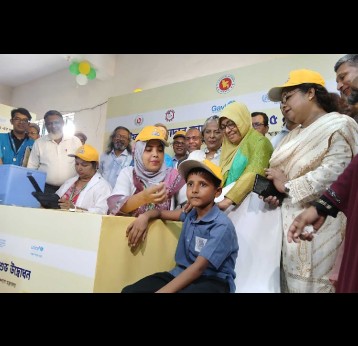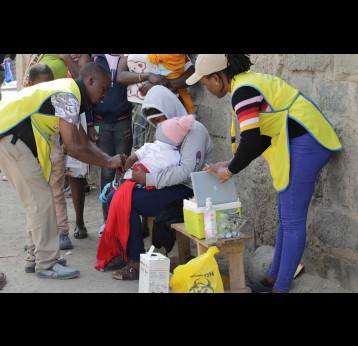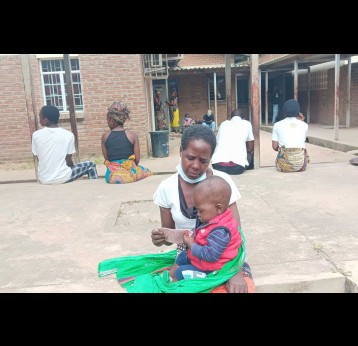The text below was current as of 2020 available data and will be updated in early 2025. For more information, visit the latest articles about typhoid. Additional information about Gavi's typhoid conjugate vaccine support: Gavi’s Annual Progress Report and Facts & figures.
Gavi's impact
Approximately 40 million children have been reached with TCV with Gavi support
PREVENTING TYPHOID AND RESPONDING TO OUTBREAKS
Gavi funding for WHO-prequalified typhoid conjugate vaccine (TCV) became available in 2018. In 2019, Pakistan became the first country to introduce the new TCV into its routine immunisation programme, using a phased approach; Liberia and Zimbabwe introduced nationwide in 2021; and Nepal in 2022. By end 2021, more than 3 million children had been reached with TCV through routine immunisation, and an additional 36 million children aged up to 15 through catch-up campaigns, implemented with Gavi support alongside routine introduction.
RENEWED MOMENTUM
While the COVID-19 pandemic initially slowed the pace of new TCV introductions, a growing body of evidence of the vaccine's high efficacy, the threat of antibiotic resistant strains of Salmonella Typhi and data-driven efforts to support country decision-making using available typhoid burden data have helped generate renewed momentum: three additional countries are planning their introductions; and others, including India, have National Immunization Technical Advisory Group (NITAG) recommendations for introduction. The Vaccine Alliance will continue supporting high-burden countries to introduce TCV – including by helping to strengthen disease diagnostic testing and surveillance, in order to assess disease burden and guide decision-making for impactful vaccine use.
The issue
Every year, 11–20 million people are infected with typhoid, mainly in low-income countries.
Typhoid fever is a life-threatening disease mainly transmitted through contaminated food or water by the bacterium Salmonella Typhi. Symptoms include prolonged fever, headache, nausea, loss of appetite, constipation and sometimes diarrhoea.
With appropriate antibiotic treatment, the case fatality rate of typhoid can drop to less than 1%. However, in recent years there has been an alarming increase in antimicrobial resistance (AMR) of Salmonella Typhi. Drug-resistance is spreading across Asia and Africa, posing a serious threat to public health. AMR is increasingly complicating typhoid fever case management, increasing the risk of complications and death, and burdening families and health care systems.
VACCINE-PREVENTABLE
Just one dose of TCV protects against typhoid fever, and is highly effective in children as young as six months of age. TCV available through Gavi support a stronger immune response, resulting in a longer duration of immunity and better protection in children than previous typhoid vaccines. Routine use of TCV in national immunisation programmes, in combination with increased access to safe water, sanitation and hygiene, is key to preventing infection and reducing the spread and burden of typhoid around the world (including resistant strains).
In October 2017, the World Health Organization (WHO) recommended the introduction of TCV for children aged over six months in endemic countries and aligned with the existing routine immunisation schedule where possible. It also recommended catch-up vaccination when feasible and appropriate, prioritising children aged up to 15 years, in order for the introduction to have the greatest impact by quickly reducing disease transmission.
Gavi’s response
Gavi prioritised TCV in 2008, as part of its Vaccine Investment Strategy, but did not make a financial commitment due to the absence of a suitable vaccine. Following the WHO prequalification of a newly available conjugated typhoid vaccine at the end of 2017, and the release of WHO Strategic Advisory Group of Experts on Immunization (SAGE) guidance on the use of TCV, Gavi opened a funding window for countries to apply for the vaccine.
INVESTING IN TCV IS CLOSELY ALIGNED WITH GAVI'S MISSION AND STRATEGIC GOALS.
- The majority of cases are among children aged under 15 years.
- While high-income countries have virtually eliminated typhoid, it is still common in low-income countries, particularly affecting communities who face multiple deprivations – including lack of access to quality water, sanitation and health services. TCV can help bridge this equity gap.
- Through our market shaping efforts, we can help to improve supply of the vaccine and encourage new manufacturers to enter the market – increasing competition and improving healthy market dynamics.
GAVI SUPPORT
In line with WHO recommendations, Gavi provides: co-financing support for nationwide introduction of TCV into the routine immunisation programme; and full financing for a one-time catch-up immunisation campaign for children aged up to 15 years based on local typhoid epidemiology. Funding support includes vaccines, vaccination supplies and operational costs for implementation.









